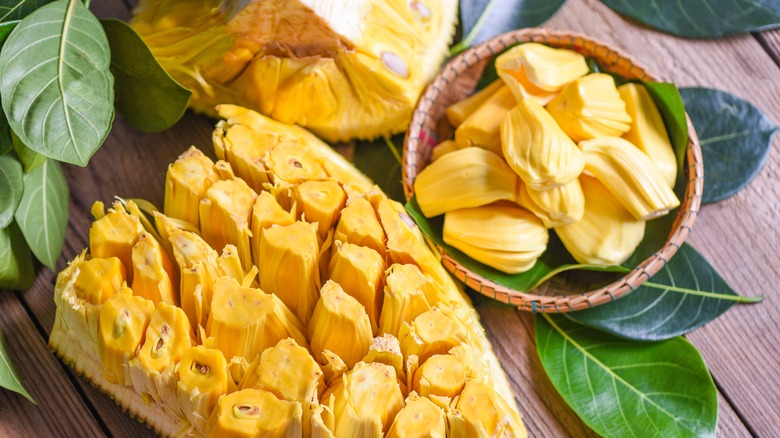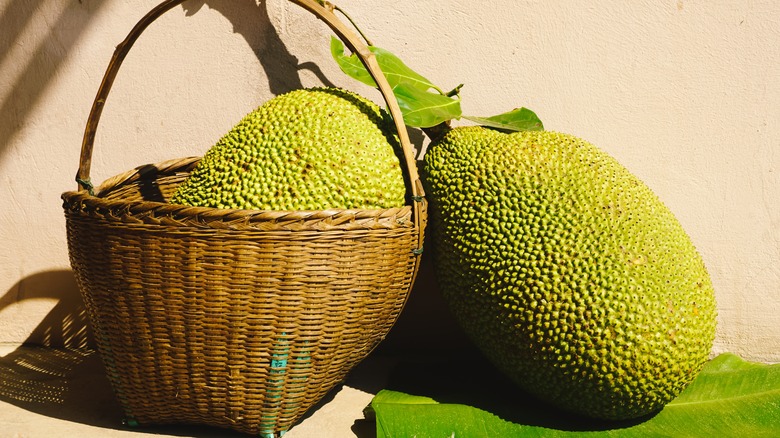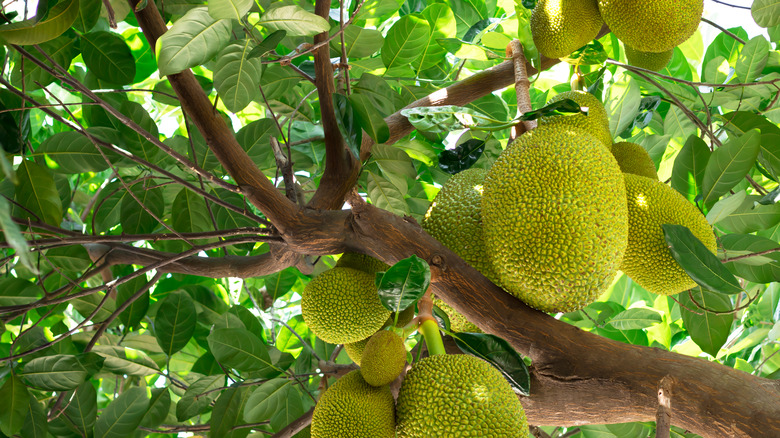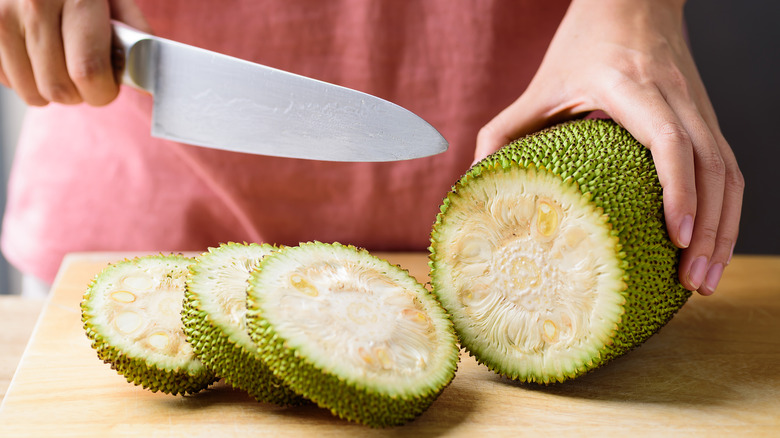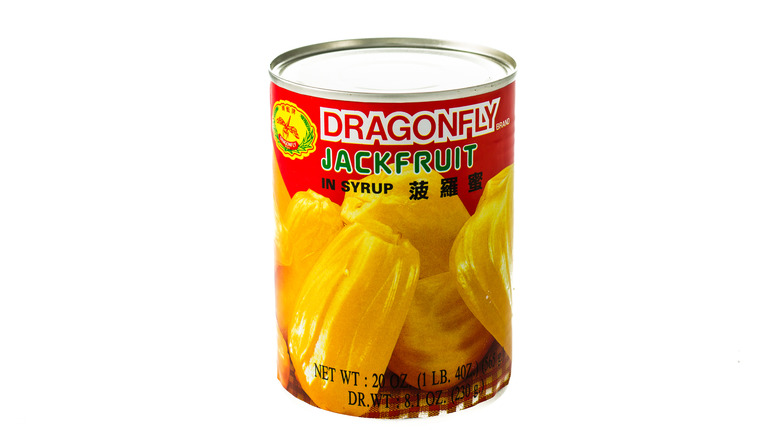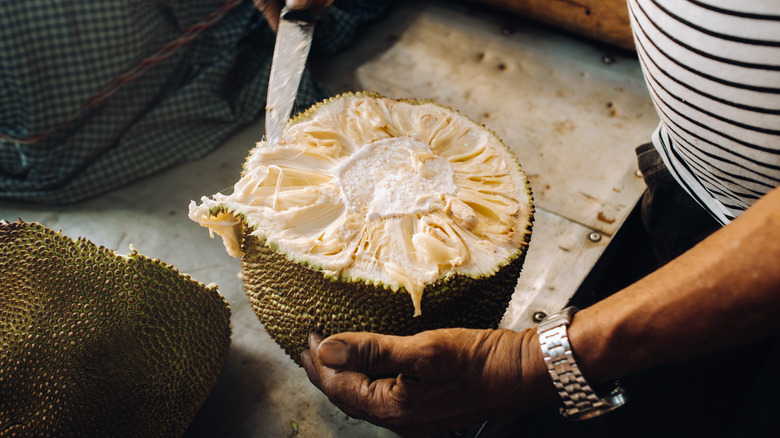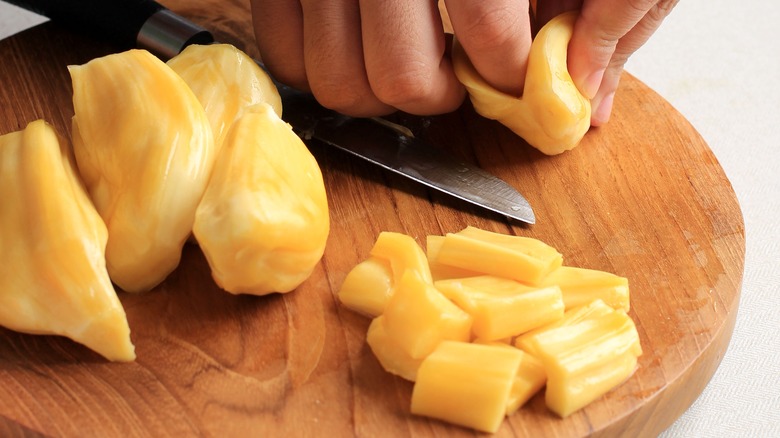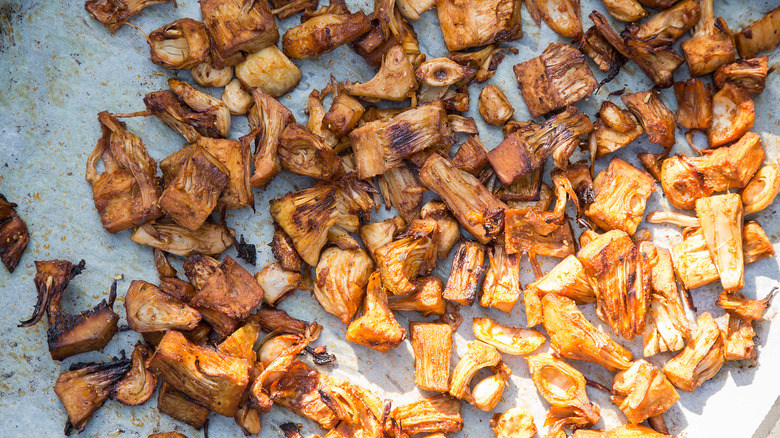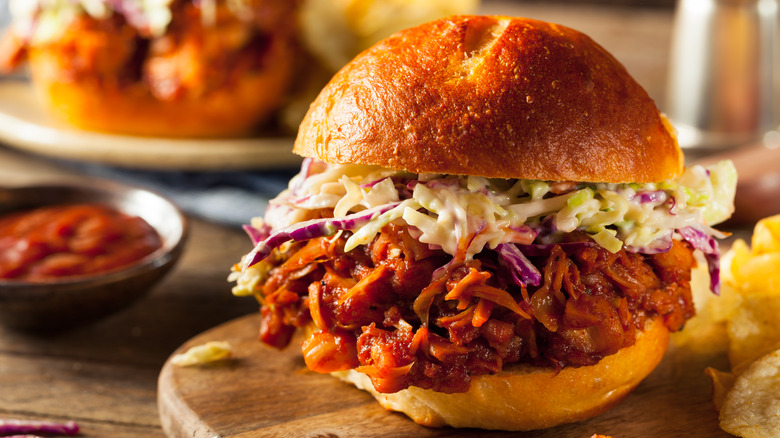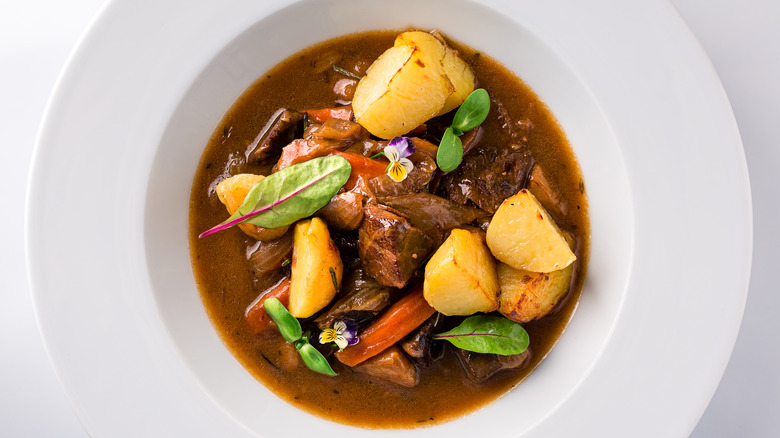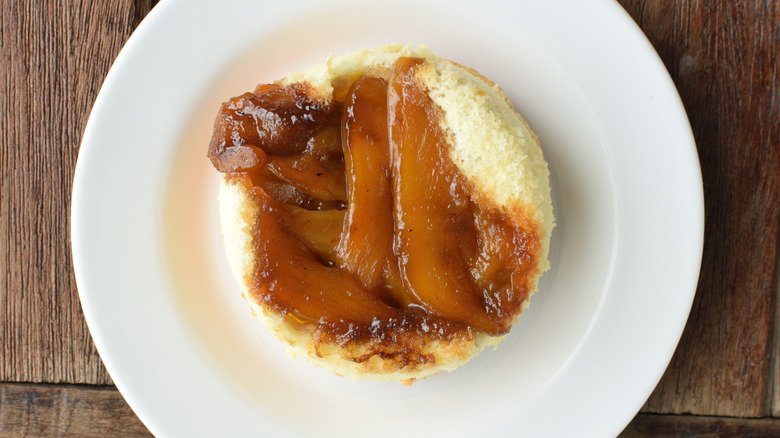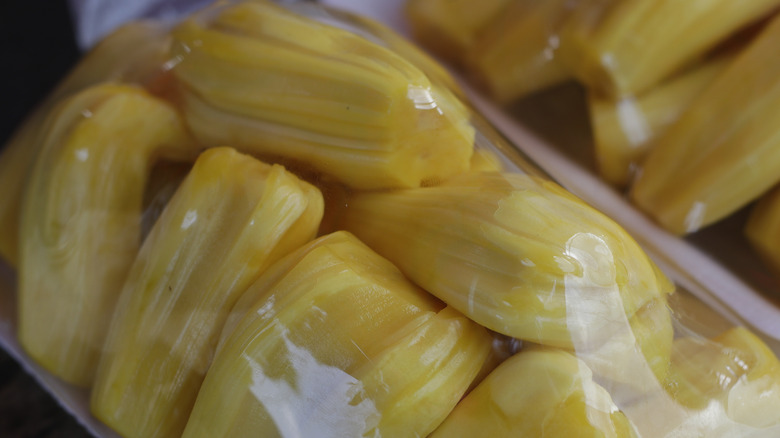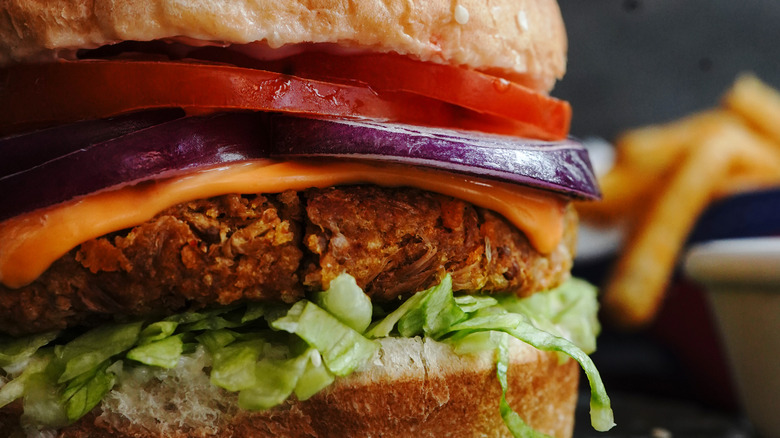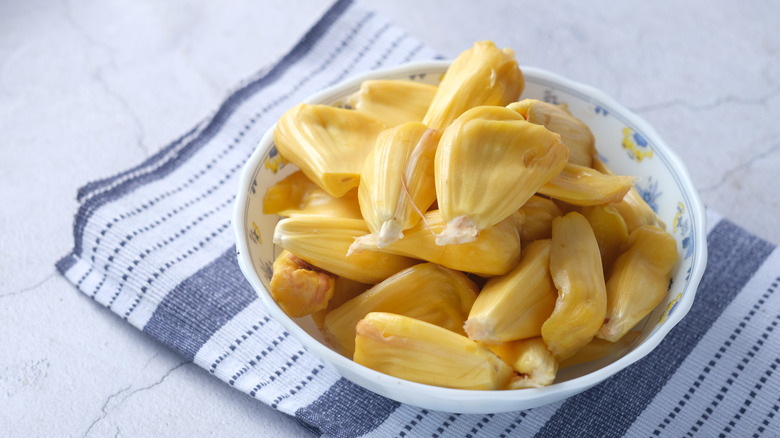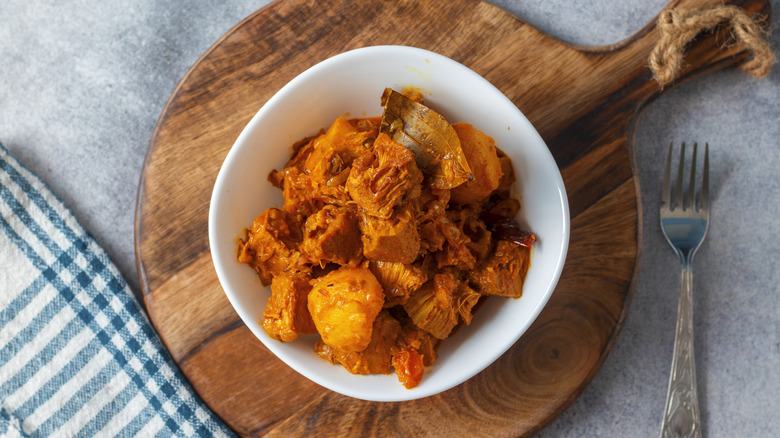What Is Jackfruit, And How To Cook With It
For most, jackfruit sounds like some made-up fruit from "Charlie and the Chocolate Factory" or Dr. Seuss. But for vegetarians, vegans, and those reducing their meat intake, jackfruit is the magical all-in-one meat replacer that's highly sought after and appreciated in any plant-based kitchen. With a new wave of vegan and vegetarian cooking taking off, the demand for veggie alternatives to animal protein is at an all-time high. Look no further with jackfruit.
The beauty of jackfruit is that it's more than just a meat replacer — it can also be a super sweet dessert-like fruit, depending on when it's harvested. It's nutrient-dense, rising in popularity, and, today, can be found all over the world. We will break it all down, from how to get your hands on it and what to do with it, to how jackfruit could end world hunger. Buckle up, fire up that stovetop, and prepare yourself to learn all about this massive, bizarre fruit that's making its name in the foodie world.
What is jackfruit?
Jackfruit is, in fact, a fruit. Although you may have enjoyed it in a savory dish, it has the potential to be incredibly sweet when ripened and prepared properly. It looks more like an alien head than your typical grocery-store fruit. On the outside, jackfruit is spiky, green, and oblong-shaped, but is related most closely to figs, breadfruit, and mulberries. Its rind is thick, tough, and bumpy, and underneath it is yellow stringy flesh separated into pods. This stringy flesh can be peeled apart like king oyster mushrooms or pineapple and is tough enough to keep its form when cooked. Once it's fully ripened and becomes much sweeter, those fibers break down and its texture is much softer.
The bizarre-looking fruit is quite versatile when it comes to both flavor and texture, and has quite a reach when it comes to our olfactory senses, as well. It's been described as smelling like bubble gum, banana, pineapple, and even rotten onion. Now, it may be more apparent why it's important to know your way around a jackfruit before you dive in head first.
Jackfruit is native to Asia
While this unique fruit may seem like something out of a science fiction movie for most Americans, it has been harvested, prepared, and enjoyed for centuries in India and Southeast Asia. In fact, the crop is fairly easy to grow and grows wild, even in people's backyards. In fact, they are so prevalent in India that loads of them go unused and rot every year. While jackfruit is native to Asia, it can be grown in almost any tropical climate and has made its way around the world from the South Pacific to Florida, U.S.A. And while we do grow jackfruit in the United States, India produces the most jackfruit of any other country and exports it around the world. Bangladesh is a close second, with Thailand and Indonesia following not too far behind. Because of this, it's most likely that the jackfruit you purchase has been grown, processed, and shipped from Asia.
While Americans are still wrapping their head around eating fruit in place of pulled pork, cultures who grew up with the fruit use it as a staple, and commonly enjoy the fruit in both sweet and savory dishes.
It's gained popularity around the world
While it may seem like jackfruit is appearing out of nowhere in the Western world, it actually has been around for quite some time. In fact, British imperialists used the highly nutritious and accessible fruit to sustain enslaved peoples in their empire. However, it wasn't until the last decade with a new rise in veganism and vegetarian eating that jackfruit became trendy and accessible for Northern Americans.
It seemed like all of a sudden, bloggers, chefs, and your vegan friend were talking about this giant, versatile fruit that could be used in place of pulled pork. The notion was intriguing, and home cooks everywhere had to get their hands on it. At the time, it was still fairly inaccessible to the average American, but slowly, manufacturers filled the niche. Today, there are absolutely plenty of ways to access the fruit, whether you're in the Midwest or the South.
Look for jackfruit at your local grocery store
A decade ago, grocers would have looked at you like you had two heads if you asked where the jackfruit selection was. Today, we have the luxury of accessing the magnificent fruit in a variety of forms. Whole, fresh jackfruit is still rather difficult to find, but it can sometimes be found in Asian grocery stores, or occasionally in large chain grocers in the produce section. This form of jackfruit tends to be less desirable to the consumer because, well, it's just too big to handle. Who needs even 10 pounds of jackfruit in one sitting, unless you're having a massive vegan barbecue? In addition, it's difficult to prepare and quite intimidating in all its glory.
Instead, consumers often opt for the canned version that has been sliced, diced, and preserved in an air-tight seal in brine. Look in the canned and jarred vegetable and fruit aisles, or with the Asian and international foods. Although less common, some markets have frozen jackfruit with frozen produce or international frozen goods. Both Trader Joe's and Whole Foods Market carry canned jackfruit. When in doubt, ask a grocery store team member to give you a hand in finding the fruit. Don't be surprised if they have to look it up; not everyone has hopped on the jackfruit train yet.
Be careful when preparing it
Like butternut squash, jackfruit is quite tricky to cut and prepare. Its tough exterior makes an incredible barrier from animals and pests in nature but can give even the sharpest knife a run for its money. The rough, spikey husk won't pierce your skin, but it is still rather intimidating to grab onto. Gather together a cutting board, your whole jackfruit, and a large sharp knife to get started in breaking down your jackfruit.
Before you begin, note that those with a latex allergy should steer clear of jackfruit. The sap contains latex and could cause an allergic reaction. For those without the allergy, start by cutting your jackfruit in half. You may have cut through some seeds, and that's okay. Begin removing the pods and squeezing the seeds out of them. The best way to do this is by rolling up your sleeves and digging in with your hands. You may have to cut the jackfruit again into quarters to reach all areas, but generally, you should peel the fruit apart like you're deseeding a pomegranate. The pods and seeds are edible and delicious when roasted, but the remaining husk and fibers should be composted.
Ripe jackfruit is sweet
In America, young jackfruit seems to have taken over the spotlight. Pig roasts are a thing of the past as people can't help but reach for a big old pile of barbecue-pulled jackfruit instead. But the truth is, savory jackfruit is simply underripe, or "young" jackfruit. There are several ways you can tell if your jackfruit is ripe and ready to eat, including using your sight, touch, and smell. Ripe jackfruit should be yellow, not green as it's typically depicted. It's okay if it has a few green spots or a light green hue to it. Next, press your fingers into the outside. If it has some give, your jackfruit is ripe. If it's firm, it's most likely underripe. Next, give it a big old whiff. If the fruit doesn't have a smell to it, it's typically not quite ripe. If it's pungent then it's most likely overripe. Look for jackfruit with a subtle musty smell that's not overwhelming.
While it may look like a durian, ripe jackfruit actually has a totally different flavor to it. Once ripe, it's sweet and tastes like a cross between a banana, mango, and pineapple. Its flesh is much softer than a young jackfruit and can be described as almost mushy. Once you crack it open you'll notice its intense sweet smell. Use ripe jackfruit in desserts, or eat it raw for a sweet snack.
Use young jackfruit as a meat replacer
The most popular use for jackfruit in the West is as a meat replacer. Young jackfruit has a much more rubbery texture than the fully ripened version. It's dryer and tougher than pineapple but peels apart in a similar way. The closest resemblance when shredded is to king oyster mushrooms or pulled pork itself.
Instead of tasting like tropical fruit, young jackfruit is rather mild and neutral in flavor which makes it the perfect vehicle for sauces and spice rubs. Just like you would flavor tofu or tempeh, or meat for that matter, create a marinade with a balance of sweetness, saltiness, heat, and acidity. Be sure to add a little fat like olive oil to help it get nice and crispy. Use a rub or marinade seasoning from your favorite barbecue cookbook, or family recipe. Peel your jackfruit apart with your fingers after it's been broken down or strained from the can, and mix it thoroughly with the seasoning. Lay it out on a sheet pan and roast it on high heat or broil it until the ends begin to crisp up. Enjoy your cholesterol-free, cruelty-free pulled chicken or pork.
Make a jackfruit pulled pork sandwich
Probably the most common use for jackfruit in the United States is to make vegan pulled pork. Because jackfruit has mildly sweet and briny undertones, it pairs perfectly with barbecue sauce, and, as we know, resembles the texture of pulled pork. Perhaps the easiest way to make a quick batch of this classic recipe is to grab canned jackfruit, your favorite store-bought barbecue sauce, an onion, some spices, and all of the fixings for freshly made coleslaw. Start by sautéing your diced onion in olive oil, along with the jackfruit. As it heats up, the fibers break down and you can easily pull it apart. Mix in spices like paprika and garlic powder, and then slowly mix in your barbecue sauce. Meanwhile, throw together some coleslaw and toast two buns. Assemble your sandwich just as you would for the classic pork version, and enjoy the ultimate jackfruit BBQ sandwich recipe.
Get creative and enjoy barbecued pulled jackfruit in tacos, on hotdogs (or tofu pups), or piled high on your flimsy paper plate alongside grilled corn and potato salad at your next backyard barbecue. Try making your own barbecue sauce from scratch, or adding ingredients to elevate your homemade barbecue sauce. Because jackfruit carries a subtle sweetness, we recommend going light on the sugar until you have a chance to taste-test your creation.
Make beef stew in your slow cooker
There's nothing better than a slow-roasted beef stew, equipped with flavorful vegetables, tender meat, and of course that thick brown gravy that trickles down a fluffy pile of mashed potatoes. If you're looking to move away from red meat, or just want to give vegetarian cooking a try, look no further for your beef replacer than jackfruit.
Simply prepare your stew how you always have. Throw your carrots, quartered onions, whole cloves of garlic, peas, celery, quartered baby mushrooms, and fresh herbs and spices into your slow cooker along with vegetable broth, corn starch, and a sweetener like brown sugar or maple syrup. And if you use a seasoning packet instead, no judgment here. Add in a strained can of jackfruit, which will be pre-cut into bite-sized triangles or whole pods, and let it all simmer until the sauce has thickened and the vegetables are tender, sweet, and delicious. Serve your stew over mashed potatoes, and enjoy tender bites of jackfruit that fall apart just like slow-cooked beef. And while it may be slightly more tender than its animal protein counterpart, it will have absorbed the flavor of the sauce while it slow cooked and will blend in flawlessly with the rest of the dish.
Use ripe jackfruit in desserts
Up until now, we've discussed what to do with young jackfruit, but what if you have a sweet tooth and want to use jackfruit as, well, a fruit? Consider making a jackfruit sticky toffee upside-down cake dessert. As aforementioned, ripe jackfruit has a similar flavor profile to that of banana or pineapple. Therefore, replacing pineapple with jackfruit in an upside-down cake isn't so far-fetched. Cook jackfruit into the stickiest caramel sauce and let those pods line the top of the cake.
In addition, ripe jackfruit can replace pineapple in any baked good recipe. It is, however, less tangy than pineapple, so don't expect quite the same punch of flavor. Blend it into a smoothie, or throw it in a food processor with frozen bananas to make jackfruit vegan ice cream. Dice jackfruit up and enjoy it over greek yogurt with a drizzle of honey. Cook and mash it and incorporate it into a pudding or sticky sauce. The fruit is incredibly sweet, and the options are endless for those with a little culinary creativity and a sweet tooth.
Store it properly
If you've broken down your own jackfruit, made some incredible recipes, and are not sure what to do with the leftover pods, you're not alone. As jackfruit is a new fruit to most Americans, it can be a little intimidating to work with. In addition, if you buy a full jackfruit, then you're working with 10 or more pounds of food, and it can become a bit overwhelming to use all at once. To keep jackfruit fresh, store it in an airtight container, or tightly wrap it in plastic wrap. It can keep in your refractor for up to seven days. If you are overwhelmed by having to use it all up before then, consider wrapping it up tightly and freezing it for up to two months.
When defrosting jackfruit, take note that it might be softer, as the fibers begin to break down once frozen and defrosted. Defrost by letting it come to temperature in the refrigerator for a few days, and then enjoy it in your next big cooking endeavor. Like most frozen fruits, once defrosted, it does well in dishes that will be heated or cooked. Once your jackfruit has been frozen once, do not freeze it again.
You can buy imitation meat jackfruit products
Maybe you're new to jackfruit and aren't even sure if you like it yet. Buying a whole fruit, or getting your hands dirty making jackfruit pulled pork, might seem like a big commitment. Instead, look for one of the pre-made jackfruit products available at the grocery store. Because of its increasing demand, manufacturers have taken notice and have put out a variety of scrumptious, pre-prepared products for the jackfruit curious.
Most notably, Upton's Naturals, along with several other companies, have created simply seasoned pulled jackfruit in a variety of flavors, including barbecue. These can be found near the tofu and pre-cooked meat replacers, or in the freezer section. In the freezer section, you can also find Jack and Annie's products, which use jackfruit to make meat alternatives like sausage and chicken nuggets. You can even order a Jack and Annie's plant-based burger from Smashburger in select locations. New jackfruit products make their way into the mainstream every day, so stay vigilant and open-minded.
It's nutrient dense
While we've established the flavor and texture of jackfruit, why choose it over pork, or even tofu for that matter? Unlike Impossible Meat or Beyond Meat, jackfruit is a whole food and is not processed. It is vegan and plant-based, meaning it's entirely made from plants, and its harvesting processes don't cause harm to animals. In addition, it's incredibly nutrient-dense and packed with protein, a nutrient not often found in large quantities in fruit.
One cup contains 155 calories, 3 grams of protein, and 3 grams of fiber. Vitamin A, vitamin C, and magnesium are all present in abundance, and the fruit is jam-packed with antioxidants that prevent inflammation and disease. Because of its fairly low glycemic index, jackfruit is suitable for most individuals to consume and can help to release a nice slow burn of energy throughout digestion. Therefore, jackfruit is not just a trendy meat replacer, it's actually a nutritious food that can aid both immunity and heart health.
Jackfruit could save the world
Because of its nutrient density, high protein content, and versatility, jackfruit could be the staple of the future we all need. The jackfruit tree itself is drought resistant and can produce up to 200 fruits per year, each weighing at least 10 pounds. This means that one jackfruit tree can make quite a difference in feeding a hungry family or sustaining an impoverished nation. As our climate changes, there is growing fear surrounding how our crops will react. Jackfruit, on the other hand, is resilient and can grow in most tropical climates.
Currently, India is working on an initiative to can and distribute the crop around the world as demand grows. In fact, in its nation of origin, it's considered to be a poor man's crop and much of it goes unharvested. In contrast, jackfruit is the trendy vegan pork alternative in the Western world, but it is also the crop that could establish food security in areas that truly need it.
